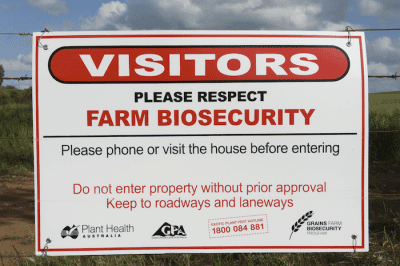 Biosecurity is a hot topic around the country as cattle, sheep and goat farmers moved to put on-farm biosecurity plans in place to meet the requirements of the Johne’s Beef Assurance Score (J-BAS) and Livestock Production Assurance (LPA) programs.
Biosecurity is a hot topic around the country as cattle, sheep and goat farmers moved to put on-farm biosecurity plans in place to meet the requirements of the Johne’s Beef Assurance Score (J-BAS) and Livestock Production Assurance (LPA) programs.
Biosecurity has become a hot topic around the country as cattle, sheep and goat farmers moved to put on-farm biosecurity plans in place to meet the requirements of the Johne’s Beef Assurance Score (J-BAS) and Livestock Production Assurance (LPA) programs.
One of the big talking points has been signage, which has raised a number of questions about privacy and farm access. This stems from a perception that having a biosecurity gate sign is a requirement under either J-BAS or LPA.
With many questions out there, the following is a short ‘fact vs fiction’ to bring producers up to speed on when, where and why signs could be used.
FICTION: I need to buy a biosecurity sign
FACT: While signage is a useful tool, signs are not required in order to have a biosecurity plan. However, your plan should incorporate a procedure for managing visitors. This can be as simple as directing people to stick to formed roads and pathways, or as comprehensive as asking them to contact you before entering the property, allowing you to discuss your expectations with them.
Signage is one of many biosecurity tools, used to alert people entering your property to the need to respect biosecurity on-farm. They can be used to gain more control over who is entering your property and why they are doing so.
If producers choose to have signs, they can use any sign that fits their needs. Some signs have a space for contact details, others simply spell out the landowner’s expectations. Your signage should address your risks in a way which is safe and practical.
FICTION: I can use my biosecurity plan to stop people like contractors entering my property.
FACT: Regardless of whether you have a sign, some visitors – such as utilities companies – may have a right of access by law, depending on legislation in your state. Your biosecurity plan cannot prevent these workers from entering, though it does give you an opportunity to work with them toward a positive outcome which satisfies both parties’ needs.
FICTION: I have to capture peoples’ details that use a gazetted road through my property.
FACT: Your visitor log or management strategy does not need to capture information about people travelling through your property on gazetted public roads. These people pose a very minimal biosecurity risk to your farm. Your visitor procedure should only deal with people visiting your farm itself, such as agents, vets, contractors or guests.
If visitors are deviating from the road on to pastures or fields without your prior consent, consider ways in which to clearly mark your private property and facilitate communication with these visitors, allowing you to assess and respond to that risk.
FICTION: I am going to fail an LPA audit with my biosecurity plan because I have to answer No to some of the questions.
FACT (and this is the big one): You cannot fail your biosecurity plan. Biosecurity is about risk management and doing the best that you can. Having a good plan is about having procedures to address potential high risk situations. When someone’s actions become a risk to your business and livelihood, implement a process to minimise the potential impact of that risk. If you need to answer N/A in the cases that that process does not apply to you that is ok. Eg if you do not have a dump on your property that is a N/A answer. Biosecurity is about improving practices. You may answer no to a question today but you could improve your business practices to reflect a yes later down the track. Eg I currently do not keep good records of my chemical usage when I spray for weeds but I should really be doing that, so I will from now on. Identify the risk and record your procedure to address the risk. That is your biosecurity plan.

I need to buy two sighs for our property and I don’t know where to get them.
Signs may not be law, but everthing possible should be done to reduce the risk of spreading disease, seeds and contamination.
Spending a small amount on signage may be a cheap investment ?
There are a range of signs available from a polite warning to a stern ‘do not enter’
QLD Banana farmers know the effects of cross farm contamination.
Clint
Mr Ladbrook, were you compensated fully for your slaughtered bulls?
In Qld we have a farm biosecurity protocol for Ergon Energy,Powerlink Qld (Govt Owned Corp) & CSG CO Origin APLNG with these entities going from property to property some with Parthenium & African Lovegrass they can’t enter our property if they have been to another property previously.This was implemented 3 years ago.We had a BJD scare with 3 bulls in 2013 but were cleared after having the bulls slaughtered.
This has answered some of my questions.